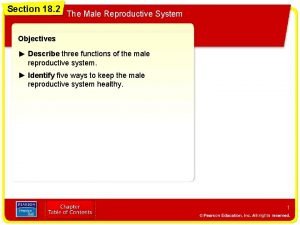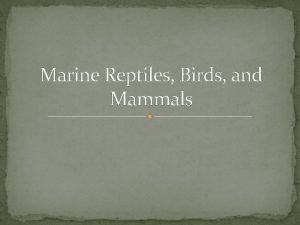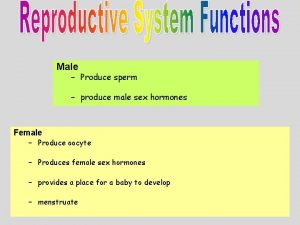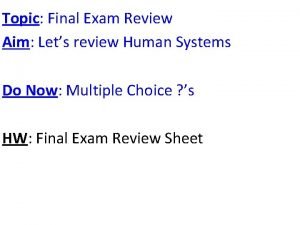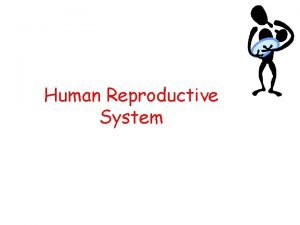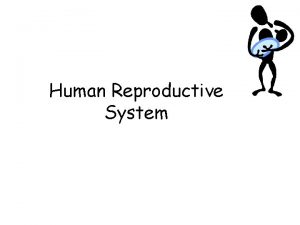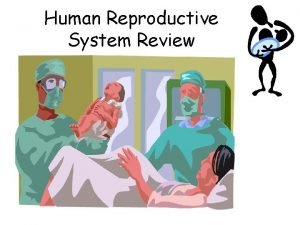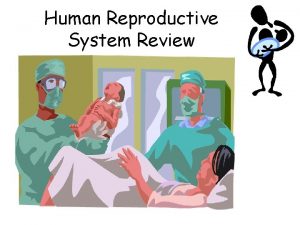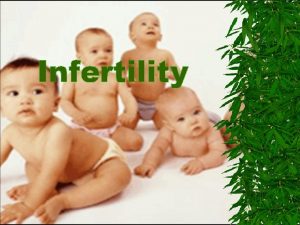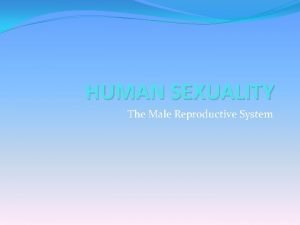Human Reproductive System Male Reproductive System Sperm Formation













- Slides: 13

Human Reproductive System

Male Reproductive System

Sperm Formation • MEIOSIS forms sperm in gametes • Sperm forms in testes • Scrotum kept cooler than the rest of the body • Semen is sperm plus protecting fluid (seminal fluid) • Semen leaves testes through the vas deferens (sperm ducts) to the urethra before it exits.

Secondary Sexual Characteristics - Male • Produced by testosterone – Deeper voice – Chest and facial hair – Lengthen bones – Increased size of testes for sperm production

Female Reproductive System

Ovum Formation • MEIOSIS forms the eggs (ova) • Eggs are formed prior to birth • 1 egg per month matures and is released from the ovaries • Eggs travel through the fallopian tube where they may become fertilized

Secondary Sexual Characteristics - Female • Induced by increased LH, FSH, estrogen, and progesterone hormone levels – Pubic hair – Widening of the pelvis – Enlargement of mammary tissue (breasts) – Begin menstrual cycles

Fertilization • • Occurs in upper 1/3 of Fallopian tube Only 1 sperm can fertilize an egg Fertilized egg = zygote An average woman is pregnant (gestational period) for 9 months or approximately 40 weeks. Babies can survive if they are born earlier, but they may have complications due to being premature.

Implantation • Fertilized eggs are implanted into thick walls of uterus • Chorion membranes dig into uterus to form placenta • Zygote grows into an embryo • Embryo gets air and nutrients through the umbilical cord • Once pregnant, progesterone levels stay high in mom, often causing nausea

1 st Trimester = 1 st 12 weeks • Heart develops first • Neural tube develops • All body systems present by Week 8 – Now a Fetus

2 nd Trimester = up to 24 weeks • Mostly growth is occuring • Looks more like a baby • Some preemies can survive at this stage

3 rd Trimester = Up to 40 weeks • • • Growth continues Kicking, rolling, stretching Eyes open – Week 32 Lungs mature Rotates to head-down position, unless baby is breech

Birth • Labor – Uterine contractions begin – Cervix dilates to 10 cm • Birth – Uterine contractions push baby through vaginal canal – Placenta delivered after baby (after birth) – Cesarean Section (c-section) is a surgical procedure that cuts through the uterus to deliver the baby if it cannot be born vaginally
 Where sperm is stored
Where sperm is stored Pathway of semen
Pathway of semen Killer whale eating sea lion
Killer whale eating sea lion From where sperm is produced
From where sperm is produced Which human organ system produces sperm or egg cells? *
Which human organ system produces sperm or egg cells? * Function of the vagina
Function of the vagina Male reproductive system and its function
Male reproductive system and its function Drawing of the male and female reproductive system
Drawing of the male and female reproductive system Exercise 42 anatomy of the reproductive system
Exercise 42 anatomy of the reproductive system Lutalphase
Lutalphase Copyright
Copyright Female and male reproductive system
Female and male reproductive system Male reproductive organ
Male reproductive organ Reproductive physiology
Reproductive physiology

